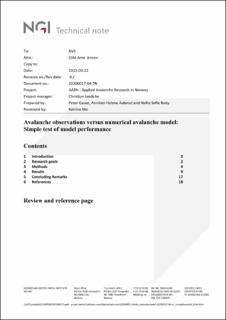Avalanche observations versus numerical avalanche model: Simple test of model performance
Research report
Permanent lenke
https://hdl.handle.net/11250/3093120Utgivelsesdato
2021-03-22Metadata
Vis full innførselSamlinger
- NGI report [198]
Sammendrag
Hazard assessment for landuse planning in snow avalanche prone areas requires, besides knowledge of return periods, the specification of expected runout distances. For a complete risk assessment, additionally, the intensity of the event, often expressed in terms of impact pressures, and the corresponding vulnerability of endangered objects are needed.
To obtain dynamical parameters, such as velocity, it has become state of practice to use 2-dimensional depth integrated avalanche models like RAMMS (Christen et al. 2010) or SAMOS-AT (Sampl and Granig, 2009). However, those models still lack a thorough and documented validation - which is partly caused by the lack of sufficient avalanche
data - and therefore, it requires extensive experience from practitioners to assess the model results. Mainly, the models are calibrated based on runout observation, however runout observations provide limited constraints for the validation of the empirical parameters used in common present-day numerical avalanche models. On the other hand side, observations of runout distances combined with velocity meas urements suggest that "major'' dry-mixed avalanches show a scale invariance to the total drop height HSC. This is in accordance to the proposed upper-limit envelope of the maximum velocity by McClung and Schaerer (2003) and a simple scaling analysis using a simple mass block model on cycloidal and parabolic tracks (Gauer, 2018). Therefore, those combined observations give a much more stringent constrain for the parameter choice.
